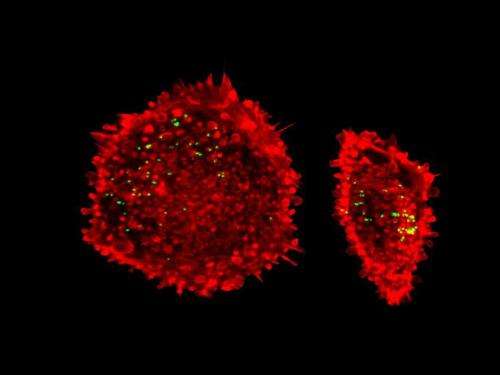Trifunctional molecule decodes cellular communication

(Phys.org)—How does one define the factors on the surface of human cells to which a molecule of interest binds? This question is typically hard to answer. Researchers of ETH Zurich have developed a new technology that enables such investigations in the context of living cells. They successfully applied this technology to virus and cancer research.
In addition to a desired clinical effect, pharmaceutical drugs often have a number of undesired side effects. In some cases, such side effects can be caused by a lack of specificity for a given cellular target. When taking into account that the cell surface is the place of action of most drugs – the following molecular picture is revealed: According to the lock-and-key model, a given drug interacts with a specific cell surface receptor molecule, which leads to the triggering or inhibition of a corresponding signalling event. However, in many cases, active substances are not entirely specific and bind to additional cell surface receptor molecules, which can lead to the triggering of undesired cellular responses. Researchers led by Bernd Wollscheid at the Institute of Molecular Systems Biology have now developed a technology, which allows for the direct identification of interactions of drugs or natural signalling molecules with cell surface protein receptors. In the future, this might enable the early detection of potential off-target effects of drugs and lead to a better understanding of cellular communication.
At the core of the new technology is a specifically designed chemical reagent that has been developed in collaboration with the group of Erick Carreira, professor at the Laboratory of Organic Chemistry. For use in cell culture experiments, the scientists incubate drugs or natural signalling molecules with living cells so that the active substances can interact with corresponding cell surface receptors. Using the newly developed reagent, such interactions are stabilized, enabling the subsequent identification of the cell surface receptors involved in the interaction.
Freezing interactions
This stabilization is made possible by the incorporation of three specific functionalities in the novel reagent. One of these functions enables coupling of the reagent to an active substance of interest while a second function captures corresponding cell surface receptor molecules on living cells. The scientists then use the third function to purify the stabilized molecular complex for subsequent analysis by mass spectrometry. Use of a sophisticated mass spectrometry-based workflow enables the identification of the captured cell surface receptors. In analogy to its three-headed nature, the scientists named their novel trifunctional reagent "Triceps".
"Our technology is very versatile", says Bernd Wollscheid. Indeed, applications of the technology are by no means limited to pharmaceutical drugs. In principle, cell surface receptors for almost any type of signaling molecule can be identified. "The molecule of interest can be a soluble protein such as an antibody in the blood or, alternatively, a surface protein of another human cell or even a pathogen, such as a virus or a bacterium." Accordingly, the technology can also be used to identify the molecules that are used by pathogens to enter our cells. In collaboration with researchers led by Jason Mercer at the Institute of Biochemistry, the team gained new insights into the infection mechanism of Vaccinia virus. Using their new technology, the researchers identified five cell surface proteins as binding factors for these viruses on human cells.
Application with tissue samples
Compared to established technologies this new method has several advantages. "For the first time, this technology enables the unbiased identification of such interactions on living cells", says ETH doctoral student Andreas Frei, the main developer of the technology. Furthermore, the technology can be used for the analysis of complex tissue samples. In experiments with tissue specimens from breast cancer patients, the researchers could identify cell surface proteins that interact with a particular drug, which is used to treat such patients. In the future, the researches want to use Triceps to elucidate complex biological mechanisms. A lot of work remains to be done. Wollscheid: "There are innumerable therapeutic and natural molecules out there for which effects on human cells have been described. However, for many of these molecules the binding factors on living cells remain unknown".
More information: Frei AP et al. Direct identification of ligand-receptor interactions on living cells and tissues. Nature Biotechnology, 2012, Advance Online Publication, DOI: 10.1038/nbt.2354
Journal information: Nature Biotechnology
Provided by ETH Zurich
















